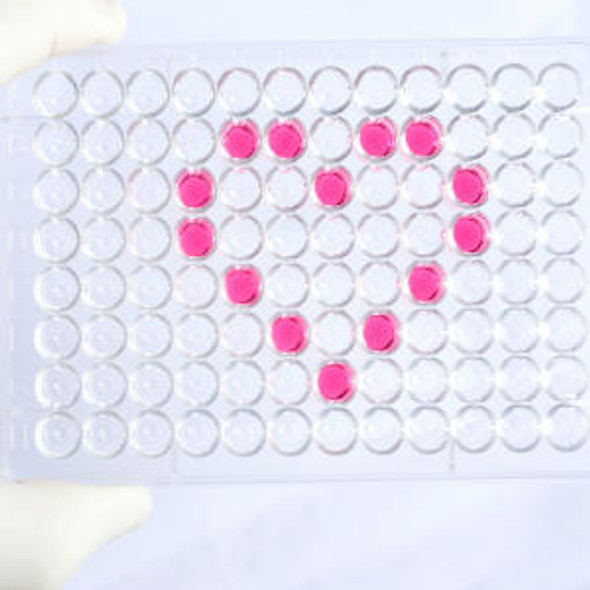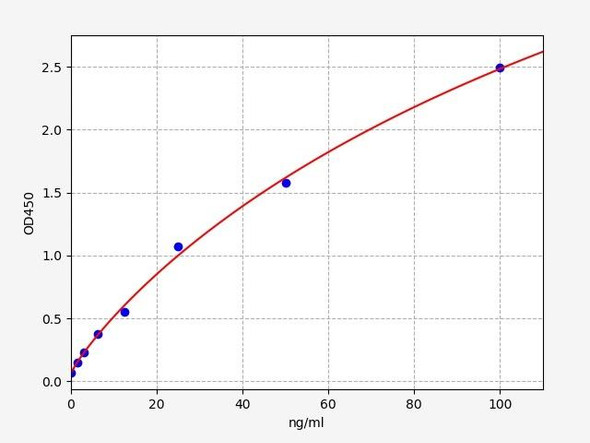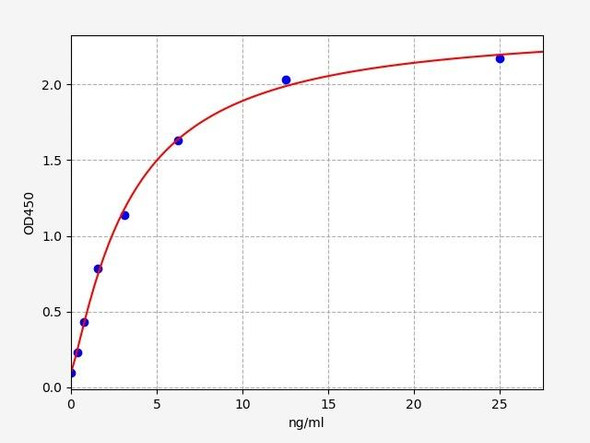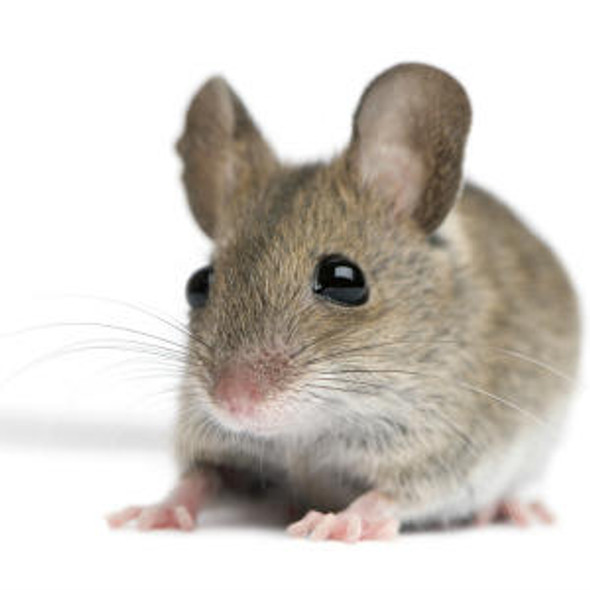Human Neuroscience ELISA Kits
Human GAD1 (Glutamate Decarboxylase 1) CLIA Kit (HUES01242)
- SKU:
- HUES01242
- Product Type:
- ELISA Kit
- ELISA Type:
- CLIA Kit
- Size:
- 96 Assays
- Sensitivity:
- 0.19ng/mL
- Range:
- 0.31-20ng/mL
- ELISA Type:
- Sandwich
- Reactivity:
- Human
- Sample Type:
- Serum, plasma and other biological fluids
- Research Area:
- Neuroscience
Description
| Assay type: | Sandwich |
| Format: | 96T |
| Assay time: | 4.5h |
| Reactivity: | Human |
| Detection method: | Chemiluminescence |
| Detection range: | 0.31-20 ng/mL |
| Sensitivity: | 0.19 ng/mL |
| Sample volume: | 100µL |
| Sample type: | Serum, plasma and other biological fluids |
| Repeatability: | CV < 15% |
| Specificity: | This kit recognizes Human GAD1 in samples. No significant cross-reactivity or interference between Human GAD1 and analogues was observed. |
This kit uses Sandwich-CLIA as the method. The micro CLIA plate provided in this kit has been pre-coated with an antibody specific to Human GAD1. Standards or samples are added to the appropriate micro CLIA plate wells and combined with the specific antibody. Then a biotinylated detection antibody specific for Human GAD1 and Avidin-Horseradish Peroxidase (HRP) conjugate are added to each micro plate well successively and incubated. Free components are washed away. The substrate solution is added to each well. Only those wells that contain Human GAD1, biotinylated detection antibody and Avidin-HRP conjugate will appear fluorescence. The Relative light unit (RLU) value is measured spectrophotometrically by the Chemiluminescence immunoassay analyzer. The RLU value is positively associated with the concentration of Human GAD1. The concentration of Human GAD1 in the samples can be calculated by comparing the RLU of the samples to the standard curve.
| UniProt Protein Function: | GAD67: Catalyzes the production of GABA. Homodimer. Isoform 3 is expressed in pancreatic islets, testis, adrenal cortex, and perhaps other endocrine tissues, but not in brain. Belongs to the group II decarboxylase family. 3 isoforms of the human protein are produced by alternative splicing. |
| UniProt Protein Details: | Protein type:EC 4. 1. 1. 15; Other Amino Acids Metabolism - beta-alanine; Other Amino Acids Metabolism - taurine and hypotaurine; Carbohydrate Metabolism - butanoate; Amino Acid Metabolism - alanine, aspartate and glutamate; Mitochondrial; Lyase Chromosomal Location of Human Ortholog: 2q31 Cellular Component: plasma membrane; intracellular; vesicle membrane Molecular Function:protein binding; glutamate binding; glutamate decarboxylase activity; protein heterodimerization activity; protein N-terminus binding; pyridoxal phosphate binding Biological Process: response to drug; glutamate catabolic process; synaptic transmission; glutamate decarboxylation to succinate; neurotransmitter secretion; gamma-aminobutyric acid biosynthetic process; protein-pyridoxal-5-phosphate linkage; neurotransmitter biosynthetic process Disease: Cerebral Palsy, Spastic Quadriplegic, 1 |
| NCBI Summary: | This gene encodes one of several forms of glutamic acid decarboxylase, identified as a major autoantigen in insulin-dependent diabetes. The enzyme encoded is responsible for catalyzing the production of gamma-aminobutyric acid from L-glutamic acid. A pathogenic role for this enzyme has been identified in the human pancreas since it has been identified as an autoantigen and an autoreactive T cell target in insulin-dependent diabetes. This gene may also play a role in the stiff man syndrome. Deficiency in this enzyme has been shown to lead to pyridoxine dependency with seizures. Alternative splicing of this gene results in two products, the predominant 67-kD form and a less-frequent 25-kD form. [provided by RefSeq, Jul 2008] |
| UniProt Code: | Q99259 |
| NCBI GenInfo Identifier: | 1352213 |
| NCBI Gene ID: | 2571 |
| NCBI Accession: | Q99259. 1 |
| UniProt Secondary Accession: | Q99259,Q49AK1, Q53TQ7, Q9BU91, Q9UHH4, |
| UniProt Related Accession: | Q99259 |
| Molecular Weight: | 66,897 Da |
| NCBI Full Name: | Glutamate decarboxylase 1 |
| NCBI Synonym Full Names: | glutamate decarboxylase 1 (brain, 67kDa) |
| NCBI Official Symbol: | GAD1 |
| NCBI Official Synonym Symbols: | GAD; SCP; CPSQ1 |
| NCBI Protein Information: | glutamate decarboxylase 1; GAD-67; 67 kDa glutamic acid decarboxylase; glutamate decarboxylase 67 kDa isoform |
| UniProt Protein Name: | Glutamate decarboxylase 1 |
| UniProt Synonym Protein Names: | 67 kDa glutamic acid decarboxylase; GAD-67; Glutamate decarboxylase 67 kDa isoform |
| Protein Family: | Glutamate decarboxylase |
| UniProt Gene Name: | GAD1 |
| UniProt Entry Name: | DCE1_HUMAN |
As the RLU values of the standard curve may vary according to the conditions of the actual assay performance (e. g. operator, pipetting technique, washing technique or temperature effects), the operator should establish a standard curve for each test. Typical standard curve and data is provided below for reference only.
| Concentration (ng/mL) | RLU | Average | Corrected |
| 20 | 33912 34052 | 33982 | 33950 |
| 10 | 12217 12723 | 12470 | 12438 |
| 5 | 5422 5078 | 5250 | 5218 |
| 2.5 | 2458 2590 | 2524 | 2492 |
| 1.25 | 1490 1276 | 1383 | 1351 |
| 0.63 | 885 849 | 867 | 835 |
| 0.31 | 606 640 | 623 | 591 |
| 0 | 31 33 | 32 | -- |
Precision
Intra-assay Precision (Precision within an assay): 3 samples with low, mid range and high level Human GAD1 were tested 20 times on one plate, respectively.
Inter-assay Precision (Precision between assays): 3 samples with low, mid range and high level Human GAD1 were tested on 3 different plates, 20 replicates in each plate.
| Intra-assay Precision | Inter-assay Precision | |||||
| Sample | 1 | 2 | 3 | 1 | 2 | 3 |
| n | 20 | 20 | 20 | 20 | 20 | 20 |
| Mean (ng/mL) | 0.99 | 2.40 | 9.36 | 1.01 | 2.23 | 10.04 |
| Standard deviation | 0.12 | 0.28 | 0.90 | 0.10 | 0.16 | 1.13 |
| C V (%) | 12.12 | 11.67 | 9.62 | 9.90 | 7.17 | 11.25 |
Recovery
The recovery of Human GAD1 spiked at three different levels in samples throughout the range of the assay was evaluated in various matrices.
| Sample Type | Range (%) | Average Recovery (%) |
| Serum (n=5) | 95-113 | 103 |
| EDTA plasma (n=5) | 98-114 | 105 |
| Cell culture media (n=5) | 102-114 | 108 |
Linearity
Samples were spiked with high concentrations of Human GAD1 and diluted with Reference Standard & Sample Diluent to produce samples with values within the range of the assay.
| Serum (n=5) | EDTA plasma (n=5) | Cell culture media (n=5) | ||
| 1:2 | Range (%) | 98-111 | 85-101 | 101-121 |
| Average (%) | 104 | 92 | 110 | |
| 1:4 | Range (%) | 97-113 | 98-110 | 99-111 |
| Average (%) | 105 | 104 | 105 | |
| 1:8 | Range (%) | 86-97 | 95-107 | 101-115 |
| Average (%) | 91 | 101 | 108 | |
| 1:16 | Range (%) | 89-105 | 95-110 | 91-108 |
| Average (%) | 96 | 102 | 98 |
An unopened kit can be stored at 4°C for 1 month. If the kit is not used within 1 month, store the items separately according to the following conditions once the kit is received.
| Item | Specifications | Storage |
| Micro CLIA Plate(Dismountable) | 8 wells ×12 strips | -20°C, 6 months |
| Reference Standard | 2 vials | |
| Concentrated Biotinylated Detection Ab (100×) | 1 vial, 120 µL | |
| Concentrated HRP Conjugate (100×) | 1 vial, 120 µL | -20°C(shading light), 6 months |
| Reference Standard & Sample Diluent | 1 vial, 20 mL | 4°C, 6 months |
| Biotinylated Detection Ab Diluent | 1 vial, 14 mL | |
| HRP Conjugate Diluent | 1 vial, 14 mL | |
| Concentrated Wash Buffer (25×) | 1 vial, 30 mL | |
| Substrate Reagent A | 1 vial, 5 mL | 4°C (shading light) |
| Substrate Reagent B | 1 vial, 5 mL | 4°C (shading light) |
| Plate Sealer | 5 pieces | |
| Product Description | 1 copy | |
| Certificate of Analysis | 1 copy |
- Set standard, test sample and control (zero) wells on the pre-coated plate and record theirpositions. It is recommended to measure each standard and sample in duplicate. Note: addall solutions to the bottom of the plate wells while avoiding contact with the well walls. Ensuresolutions do not foam when adding to the wells.
- Aliquot 100 µL of standard solutions into the standard wells.
- Add 100 µL of Sample / Standard dilution buffer into the control (zero) well.
- Add 100 µL of properly diluted sample (serum, plasma, tissue homogenates and otherbiological fluids. ) into test sample wells.
- Cover the plate with the sealer provided in the kit and incubate for 90 min at 37 °C.
- Aspirate the liquid from each well, do not wash. Immediately add 100 µL of BiotinylatedDetection Ab working solution to each well. Cover the plate with a plate seal and gently mix. Incubate for 1 hour at 37 °C.
- Aspirate or decant the solution from the plate and add 350 µL of wash buffer to each welland incubate for 1-2 minutes at room temperature. Aspirate the solution from each well andclap the plate on absorbent filter paper to dry. Repeat this process 3 times. Note: a microplatewasher can be used in this step and other wash steps.
- Add 100 µL of HRP Conjugate working solution to each well. Cover with a plate seal andincubate for 30 min at 37 °C.
- Aspirate or decant the solution from each well. Repeat the wash process for five times asconducted in step 7.
- Add 100 µL of Substrate mixture solution to each well. Cover with a new plate seal andincubate for no more than 5 min at 37 °C. Protect the plate from light.
- Determine the RLU value of each well immediately.






